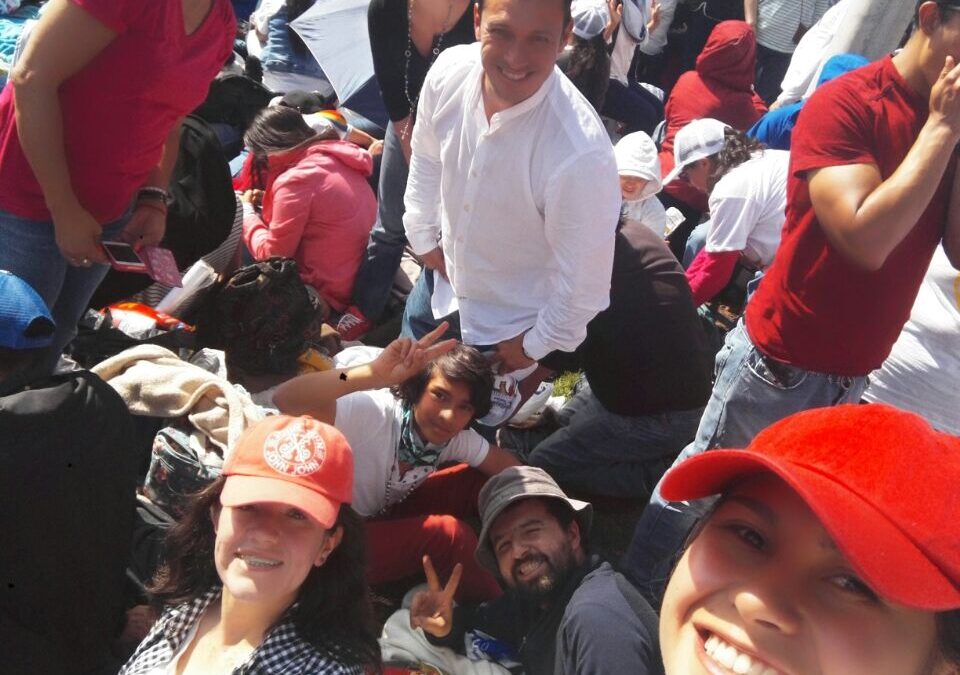
Sep 13, 2017 | Focolare Worldwide
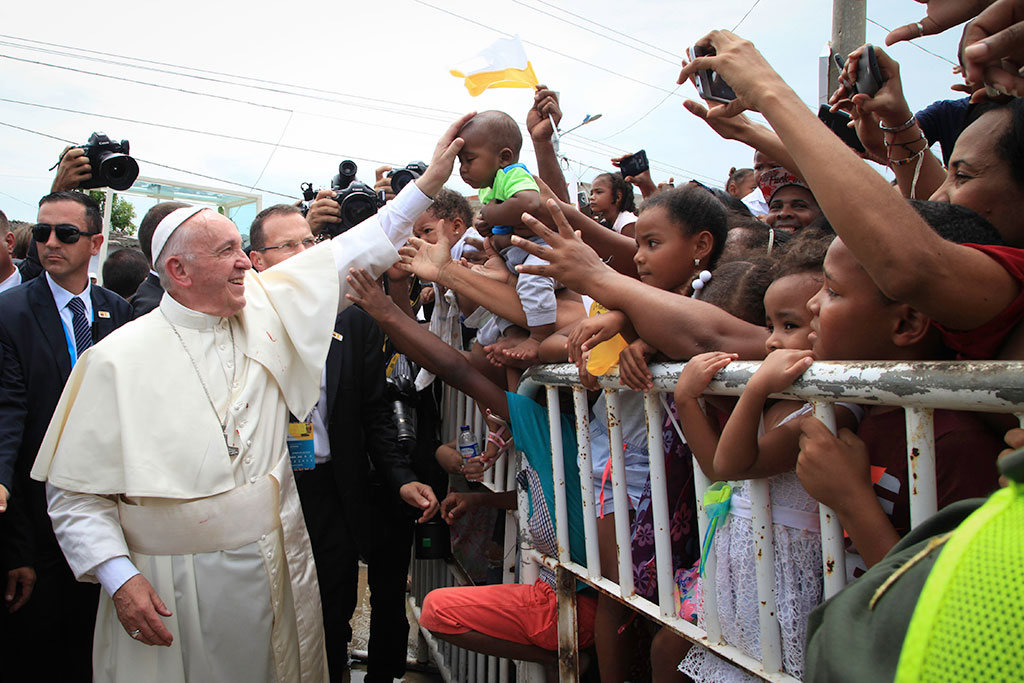
Foto: Jose-MIguel-Gomez – Conferenza Episcopale Colombiana
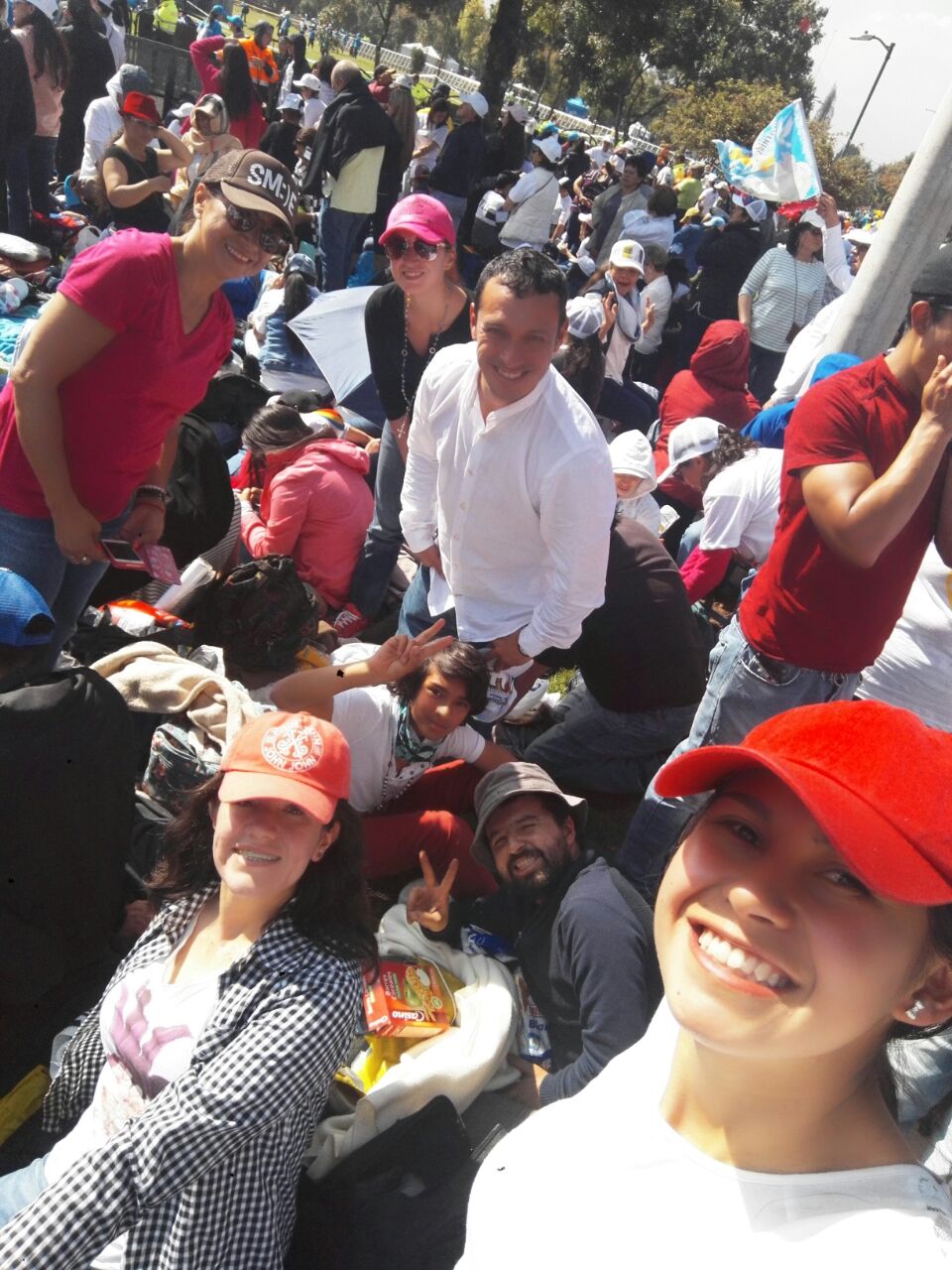 Cartagena de Indias, north of Colombia, is the home of the Shrine of St Peter Claver (1581-1654). He was declared a saint in 1888 and had been a Spanish Jesuit who dedicated himself to the tragic victims of slavery. At the suggestion of the Jesuits, after the peace accord between the government and the Farc which had put an end to the 50 years of conflict with 200 thousand dead and tens of thousands missing, it became the capital of human rights. The Pope visited the poorest neighbourhoods, stopping in at the house of 77 year old Lorenza Perez, who cooks and distributes meals to anyone in need. “I’m the poorest of the poor,” she says. “But the Pope chose my house to tell the world to have more love for those that are discarded. Susanna Nuin explains: “The Pope’s speeches had two dimensions: on conceptual, with strong and precise clarifications; and the other gestural, to express his closeness to a people that has suffered much. His departure left us with a sense of loss, but also a sense of fulfilment. His visit has instilled a new way of living in the hearts of the Colombian people, no longer from a passive stance, waiting for a peace that never comes, succumbing to a polarization that makes peaceful coexistence impossible. The young people played a fundamental role, who felt like they had been invested with a task. Yolima Martínez recalls the Pope’s appeal: “You young people have a special gift for recognizing the suffering of others.” Laura Isaza: “Peace is a process that engages all generations, but ours especially.” Manuel echoes her words: “The Pope’s visit has clarified to the Colombians that peace isn’t a political matter, but culture that needs to be built. As Focolare members we feel even more committed to listen to Pope Francis when he talks about a culture of encounter that we have to continue to build.”
Cartagena de Indias, north of Colombia, is the home of the Shrine of St Peter Claver (1581-1654). He was declared a saint in 1888 and had been a Spanish Jesuit who dedicated himself to the tragic victims of slavery. At the suggestion of the Jesuits, after the peace accord between the government and the Farc which had put an end to the 50 years of conflict with 200 thousand dead and tens of thousands missing, it became the capital of human rights. The Pope visited the poorest neighbourhoods, stopping in at the house of 77 year old Lorenza Perez, who cooks and distributes meals to anyone in need. “I’m the poorest of the poor,” she says. “But the Pope chose my house to tell the world to have more love for those that are discarded. Susanna Nuin explains: “The Pope’s speeches had two dimensions: on conceptual, with strong and precise clarifications; and the other gestural, to express his closeness to a people that has suffered much. His departure left us with a sense of loss, but also a sense of fulfilment. His visit has instilled a new way of living in the hearts of the Colombian people, no longer from a passive stance, waiting for a peace that never comes, succumbing to a polarization that makes peaceful coexistence impossible. The young people played a fundamental role, who felt like they had been invested with a task. Yolima Martínez recalls the Pope’s appeal: “You young people have a special gift for recognizing the suffering of others.” Laura Isaza: “Peace is a process that engages all generations, but ours especially.” Manuel echoes her words: “The Pope’s visit has clarified to the Colombians that peace isn’t a political matter, but culture that needs to be built. As Focolare members we feel even more committed to listen to Pope Francis when he talks about a culture of encounter that we have to continue to build.”
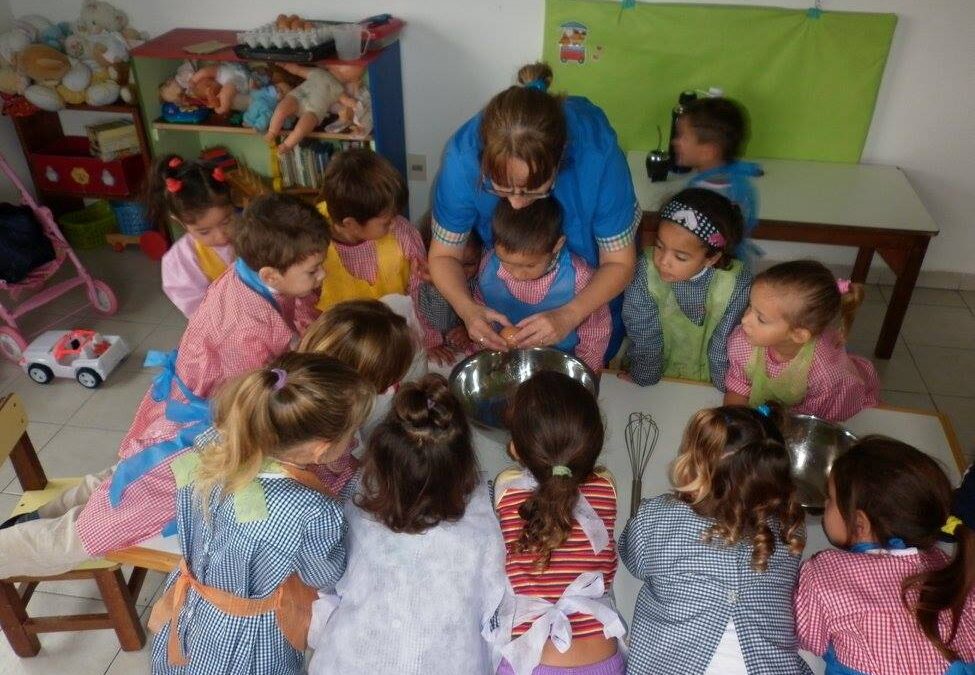
Sep 12, 2017 | Non categorizzato
 Thousands of young people are preparing for the Genfest by seizing opportunities to promote universal brotherhood across the globe. Not as noisy as the wars and bombings, less worth it for the crime channels, but factual and quite effective when it comes to building a world without barbed wire borders, hatred and indifference. It’s the MILONGA Project, not a place for dancing the tango, but an international volunteer programme that does have some similarities with the Latin American dance style known as tango: with its fast pace, its warmth and generous spirit. This communication network connects thousands of social projects around the world. It’s known as the MILONGA Project. MILONGA is an acronym formed by the Italian words for: a thousand non-governmental organizations in action (www.milongaproject.org) that are all inspired by the Focolare’s charism of unity. The young men and women who belong to the project not only volunteer, but also expand their hearts as they open themselves to the rich cultures of other countries. Promoted by the International New Humanity Association and by Youth for a United world, the MILONGA Project went through a pilot phase in Latin America (Argentina, Bolivia, Brazil, Mexico, Paraguay, Venezuela and Uruguay). Now, it is also active in Italy, Croatia Jordan, Philippines, Kenya and Tanzania.
Thousands of young people are preparing for the Genfest by seizing opportunities to promote universal brotherhood across the globe. Not as noisy as the wars and bombings, less worth it for the crime channels, but factual and quite effective when it comes to building a world without barbed wire borders, hatred and indifference. It’s the MILONGA Project, not a place for dancing the tango, but an international volunteer programme that does have some similarities with the Latin American dance style known as tango: with its fast pace, its warmth and generous spirit. This communication network connects thousands of social projects around the world. It’s known as the MILONGA Project. MILONGA is an acronym formed by the Italian words for: a thousand non-governmental organizations in action (www.milongaproject.org) that are all inspired by the Focolare’s charism of unity. The young men and women who belong to the project not only volunteer, but also expand their hearts as they open themselves to the rich cultures of other countries. Promoted by the International New Humanity Association and by Youth for a United world, the MILONGA Project went through a pilot phase in Latin America (Argentina, Bolivia, Brazil, Mexico, Paraguay, Venezuela and Uruguay). Now, it is also active in Italy, Croatia Jordan, Philippines, Kenya and Tanzania. 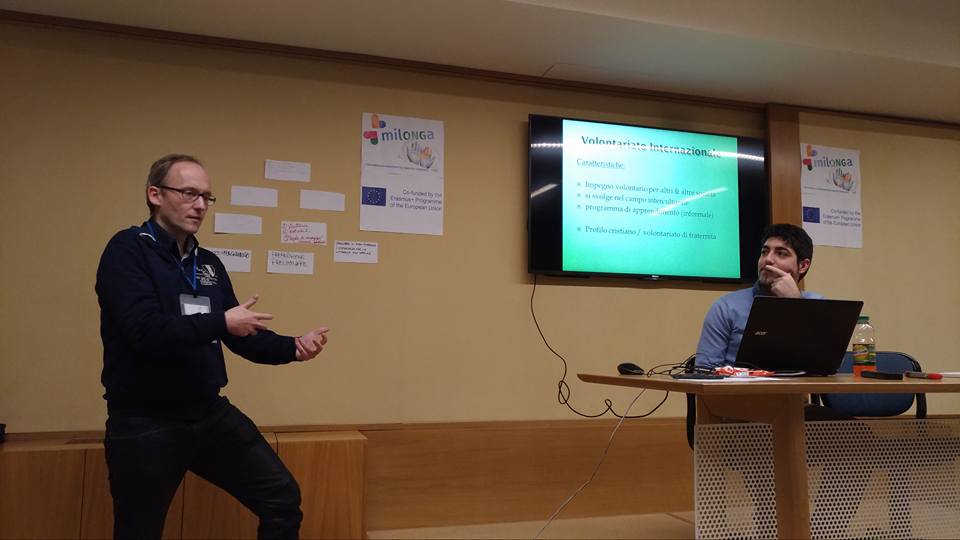 On August 5th, representatives from the Focolare’s permanent Mariapolises around the world, and representatives from various NGOs, met for one week at the Mariapolis in Brazil to discuss strategies for further network development, examining strategic and management aspects of the program, selection and accompaniment, monitoring and reception of participants into the project; and also to offer a quality formation process that will have a positive impact on both the individual volunteers and on the host communities. Sixty young people who participated in the pilot projects will now have the opportunity to fulfil their dream of volunteering beyond their own borders. MILONGA provides training in preparation for the arrival in the host country, with an indvidualized training program for each volunteer, as well as for the host entity in the other country. It provides a trainer that accompanies the young person through every phase of the experience – training, stay and return to one’s own country. It also ensures that the young person will be welcomed by the local Mariapolis and Focolare community and have a direct experience of the local environment. Each participant has an opportunity to interact with peers on an international level by linking up with the United World Project.
On August 5th, representatives from the Focolare’s permanent Mariapolises around the world, and representatives from various NGOs, met for one week at the Mariapolis in Brazil to discuss strategies for further network development, examining strategic and management aspects of the program, selection and accompaniment, monitoring and reception of participants into the project; and also to offer a quality formation process that will have a positive impact on both the individual volunteers and on the host communities. Sixty young people who participated in the pilot projects will now have the opportunity to fulfil their dream of volunteering beyond their own borders. MILONGA provides training in preparation for the arrival in the host country, with an indvidualized training program for each volunteer, as well as for the host entity in the other country. It provides a trainer that accompanies the young person through every phase of the experience – training, stay and return to one’s own country. It also ensures that the young person will be welcomed by the local Mariapolis and Focolare community and have a direct experience of the local environment. Each participant has an opportunity to interact with peers on an international level by linking up with the United World Project. 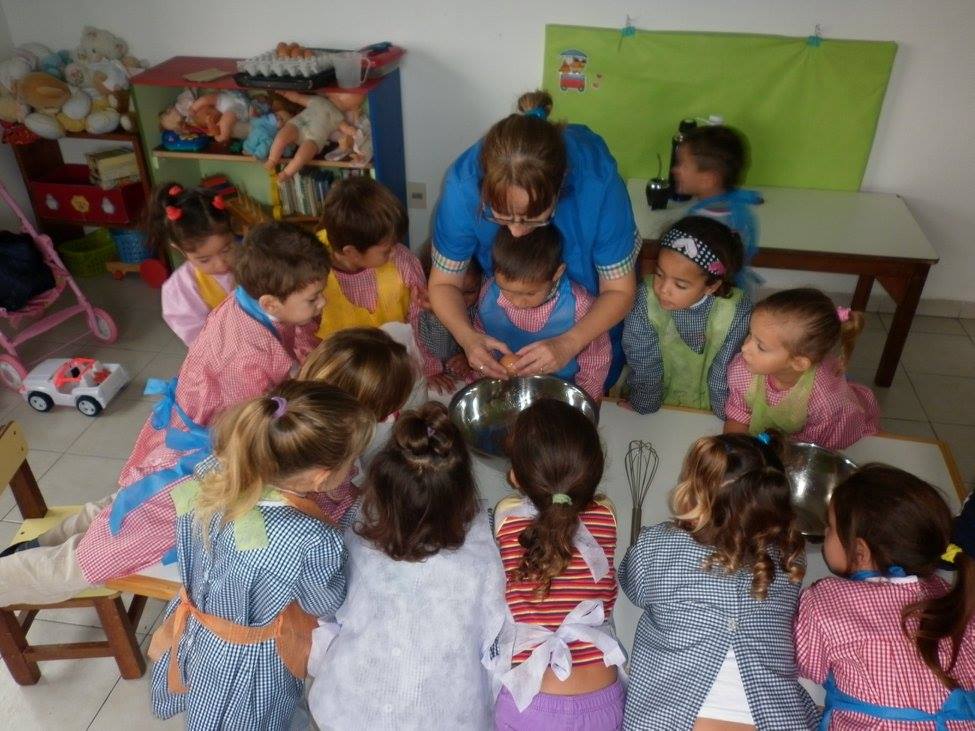 MILONGA’s method emerges from an experience that has matured over years, and from the impact that the volunteer experience is having in a variety of settings. It is a rather unique style of social action, in which the fraternal bond among the different actors is the main key. Fraternity is also the key in motivating the encounter of the different communities in vulnerable situations, to bring about an experience of communion with the volunteers, and experience of dialogue and real intercultural exchange, in order to discover together solutions that do not come from above, but are as much as possible shared in a reciprocal way. “It’s not so easy to put into a few words what I experienced for a month at the Casa de los Niños (Children’s Home) in Cochabamba,” says an Uruguayan volunteer at an NGO in Bolivia. “After New Year’s I was headed for an adventure that I had been thinking about for some time, saving money and getting my heart ready. I wanted to go with an NGO that had the Focolare spirit, and I was surprised by the brotherhood I experienced throughout every moment.” “I got to know a social reality that is very different from the one we live,” says a young Spanish volunteer, “a very powerful reality that helped me, not so much to be aware of certain problems, because perhaps I already had some knowledge of them, but to recognize and accept the fact that beyond where we come from, how much money we have, where we live – we’re all equal and the same.”
MILONGA’s method emerges from an experience that has matured over years, and from the impact that the volunteer experience is having in a variety of settings. It is a rather unique style of social action, in which the fraternal bond among the different actors is the main key. Fraternity is also the key in motivating the encounter of the different communities in vulnerable situations, to bring about an experience of communion with the volunteers, and experience of dialogue and real intercultural exchange, in order to discover together solutions that do not come from above, but are as much as possible shared in a reciprocal way. “It’s not so easy to put into a few words what I experienced for a month at the Casa de los Niños (Children’s Home) in Cochabamba,” says an Uruguayan volunteer at an NGO in Bolivia. “After New Year’s I was headed for an adventure that I had been thinking about for some time, saving money and getting my heart ready. I wanted to go with an NGO that had the Focolare spirit, and I was surprised by the brotherhood I experienced throughout every moment.” “I got to know a social reality that is very different from the one we live,” says a young Spanish volunteer, “a very powerful reality that helped me, not so much to be aware of certain problems, because perhaps I already had some knowledge of them, but to recognize and accept the fact that beyond where we come from, how much money we have, where we live – we’re all equal and the same.”
Sep 11, 2017 | Focolare Worldwide
After Hurricane Irma’s passage over the Caribbean where it caused death and destruction, the violent storm hit Florida, which has been declared in a state of emergency. More than 5.8 million people have been left without electricity, running water or internet. Five deaths have been confirmed. It has now weakened to a category 1 hurricane, with 136 kilometer winds, and is now heading towards Atlanta, Georgia. The local Focolare community writes: “We’re in constant contact with our community in Florida. Many have had to leave their homes and find safe places to stay. They tell us that they are trying to help people who are all alone, neighbors and parents and relatives living outside the country, and the same goes for the communities on the islands. The weakening hurricane is expected to arrive in Atlanta on Monday or Tuesday with a lot of rain and strong wind. We are seeing God’s love in all of this and experiencing how much we’re all brothers and sisters, thanks to this crisis. We’re finding that we can help each other, beyond the social divisions that are quite secondary now.”
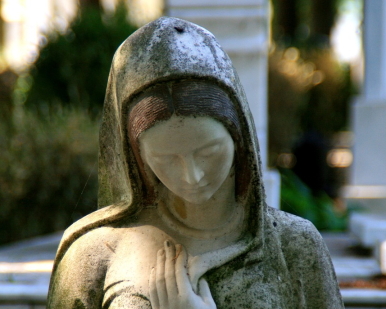
Sep 9, 2017 | Non categorizzato
 Mary’s children interpret her in many ways, all of them beautiful, but her most sumptuous beauty can be found in the singular position she holds among women. Hers is a name that we will never finish saying, a name that will continue to fill us with happiness every time we hear it. In the Angelic Salutation that has flown through history as a source of gladness, millions upon millions have greeted her in the same manner. With every Hail Mary all of us go back to that familiar salute, in the hope of obtaining her intercession in this human experiment called life, which culminates in death, the threshold of the everlasting life. “Mary!” Just saying her name makes our heart jump for joy, like the child in Elizabeth’s womb – “and Elizabeth was filled with the Holy Spirit.” “Mary!” This is what shepherds and carpenters said as they came to the door of that semblance of a stall, which was the home of the Holy Family on the Nazareth hillside. “Mary” they called her, as they went on to ask a favour, because she was always willing to serve anyone and full of possibilities for everyone. And if they didn’t have favours to ask, they would show up simply because of the pleasure it gave them to greet her with that name, which was filled with beauty and wonder because it summarized all the mysteries of love. “Mary”, the feminine word for Love… Like Archangel Gabriel, Joseph, the saints, and many sinners, we continue centuries later to call her by that same name, fifty, a hundred, or more times a day. We never pin on to it noble titles, high-sounding appellatives, primacy or rank. We prefer – as she prefers – to draw her closer to us and to never draw far from her, so that we can draw near to the Spouse who shares a singular unity with her. The rush of the crowds, whirlwind of the passions and traces of the Spirit that vein human history are filled with that name, through which love travels from the depths of the earth to heights of Heaven. Humility draws closer, and love unites: this is the great tribute. We feel at home in Christ’s Church, we feel at home in the Communion of Saints in the orbit of the Trinity: because Mary is there. The Mother is there, and so the children can come in. Wherever there is Mary, there is love. Wherever there is love, there is God. Just to say the name of Mary in whatever place or circumstance, is to step into a divine atmosphere in a single breath, to light a star in the middle of the night, to unlock the healing flow of poetry in the midst of a technological plague, to make a swamp blossom with lilies. To say Mary is to restore the warmth of a family to a world that seems to have become a forced labour camp. Mary loves and hides herself in love: Real love is contemplation of the beloved. Also in this, by imitating the young woman from Nazareth, we can be contemplatives in the midst of the world, in the hovel of a country farm house or in the apartment of a city dwelling. The love in Mary was so great that she provided God to us – God who is Love. She all but ripped him from Heaven in order to give him to earth. She made the Holy One one of us, a man at the service of all. Truly, love means making yourself one with the Beloved. Mary became so one with God that he gave himself over to her so that, through her, he would give himself to all people. Ultimately, you are in the world, in a different time and place, but, being there like Mary, you are always and everywhere preparing the place for Jesus to stay. (Igino Giordani, Maria modello perfetto, (Rome: Città Nuova, 2012), 17-20.
Mary’s children interpret her in many ways, all of them beautiful, but her most sumptuous beauty can be found in the singular position she holds among women. Hers is a name that we will never finish saying, a name that will continue to fill us with happiness every time we hear it. In the Angelic Salutation that has flown through history as a source of gladness, millions upon millions have greeted her in the same manner. With every Hail Mary all of us go back to that familiar salute, in the hope of obtaining her intercession in this human experiment called life, which culminates in death, the threshold of the everlasting life. “Mary!” Just saying her name makes our heart jump for joy, like the child in Elizabeth’s womb – “and Elizabeth was filled with the Holy Spirit.” “Mary!” This is what shepherds and carpenters said as they came to the door of that semblance of a stall, which was the home of the Holy Family on the Nazareth hillside. “Mary” they called her, as they went on to ask a favour, because she was always willing to serve anyone and full of possibilities for everyone. And if they didn’t have favours to ask, they would show up simply because of the pleasure it gave them to greet her with that name, which was filled with beauty and wonder because it summarized all the mysteries of love. “Mary”, the feminine word for Love… Like Archangel Gabriel, Joseph, the saints, and many sinners, we continue centuries later to call her by that same name, fifty, a hundred, or more times a day. We never pin on to it noble titles, high-sounding appellatives, primacy or rank. We prefer – as she prefers – to draw her closer to us and to never draw far from her, so that we can draw near to the Spouse who shares a singular unity with her. The rush of the crowds, whirlwind of the passions and traces of the Spirit that vein human history are filled with that name, through which love travels from the depths of the earth to heights of Heaven. Humility draws closer, and love unites: this is the great tribute. We feel at home in Christ’s Church, we feel at home in the Communion of Saints in the orbit of the Trinity: because Mary is there. The Mother is there, and so the children can come in. Wherever there is Mary, there is love. Wherever there is love, there is God. Just to say the name of Mary in whatever place or circumstance, is to step into a divine atmosphere in a single breath, to light a star in the middle of the night, to unlock the healing flow of poetry in the midst of a technological plague, to make a swamp blossom with lilies. To say Mary is to restore the warmth of a family to a world that seems to have become a forced labour camp. Mary loves and hides herself in love: Real love is contemplation of the beloved. Also in this, by imitating the young woman from Nazareth, we can be contemplatives in the midst of the world, in the hovel of a country farm house or in the apartment of a city dwelling. The love in Mary was so great that she provided God to us – God who is Love. She all but ripped him from Heaven in order to give him to earth. She made the Holy One one of us, a man at the service of all. Truly, love means making yourself one with the Beloved. Mary became so one with God that he gave himself over to her so that, through her, he would give himself to all people. Ultimately, you are in the world, in a different time and place, but, being there like Mary, you are always and everywhere preparing the place for Jesus to stay. (Igino Giordani, Maria modello perfetto, (Rome: Città Nuova, 2012), 17-20.

 Cartagena de Indias, north of Colombia, is the home of the Shrine of St Peter Claver (1581-1654). He was declared a saint in 1888 and had been a Spanish Jesuit who dedicated himself to the tragic victims of slavery. At the suggestion of the Jesuits, after the peace accord between the government and the Farc which had put an end to the 50 years of conflict with 200 thousand dead and tens of thousands missing, it became the capital of human rights. The Pope visited the poorest neighbourhoods, stopping in at the house of 77 year old Lorenza Perez, who cooks and distributes meals to anyone in need. “I’m the poorest of the poor,” she says. “But the Pope chose my house to tell the world to have more love for those that are discarded. Susanna Nuin explains: “The Pope’s speeches had two dimensions: on conceptual, with strong and precise clarifications; and the other gestural, to express his closeness to a people that has suffered much. His departure left us with a sense of loss, but also a sense of fulfilment. His visit has instilled a new way of living in the hearts of the Colombian people, no longer from a passive stance, waiting for a peace that never comes, succumbing to a polarization that makes peaceful coexistence impossible. The young people played a fundamental role, who felt like they had been invested with a task. Yolima Martínez recalls the Pope’s appeal: “You young people have a special gift for recognizing the suffering of others.” Laura Isaza: “Peace is a process that engages all generations, but ours especially.” Manuel echoes her words: “The Pope’s visit has clarified to the Colombians that peace isn’t a political matter, but culture that needs to be built. As Focolare members we feel even more committed to listen to Pope Francis when he talks about a culture of encounter that we have to continue to build.”
Cartagena de Indias, north of Colombia, is the home of the Shrine of St Peter Claver (1581-1654). He was declared a saint in 1888 and had been a Spanish Jesuit who dedicated himself to the tragic victims of slavery. At the suggestion of the Jesuits, after the peace accord between the government and the Farc which had put an end to the 50 years of conflict with 200 thousand dead and tens of thousands missing, it became the capital of human rights. The Pope visited the poorest neighbourhoods, stopping in at the house of 77 year old Lorenza Perez, who cooks and distributes meals to anyone in need. “I’m the poorest of the poor,” she says. “But the Pope chose my house to tell the world to have more love for those that are discarded. Susanna Nuin explains: “The Pope’s speeches had two dimensions: on conceptual, with strong and precise clarifications; and the other gestural, to express his closeness to a people that has suffered much. His departure left us with a sense of loss, but also a sense of fulfilment. His visit has instilled a new way of living in the hearts of the Colombian people, no longer from a passive stance, waiting for a peace that never comes, succumbing to a polarization that makes peaceful coexistence impossible. The young people played a fundamental role, who felt like they had been invested with a task. Yolima Martínez recalls the Pope’s appeal: “You young people have a special gift for recognizing the suffering of others.” Laura Isaza: “Peace is a process that engages all generations, but ours especially.” Manuel echoes her words: “The Pope’s visit has clarified to the Colombians that peace isn’t a political matter, but culture that needs to be built. As Focolare members we feel even more committed to listen to Pope Francis when he talks about a culture of encounter that we have to continue to build.”





 MILONGA’s method emerges from an experience that has matured over years, and from the impact that the volunteer experience is having in a variety of settings. It is a rather unique style of social action, in which the fraternal bond among the different actors is the main key. Fraternity is also the key in motivating the encounter of the different communities in vulnerable situations, to bring about an experience of communion with the volunteers, and experience of dialogue and real intercultural exchange, in order to discover together solutions that do not come from above, but are as much as possible shared in a reciprocal way. “It’s not so easy to put into a few words what I experienced for a month at the Casa de los Niños (Children’s Home) in Cochabamba,” says an Uruguayan volunteer at an NGO in Bolivia. “After New Year’s I was headed for an adventure that I had been thinking about for some time, saving money and getting my heart ready. I wanted to go with an NGO that had the Focolare spirit, and I was surprised by the brotherhood I experienced throughout every moment.” “I got to know a social reality that is very different from the one we live,” says a young Spanish volunteer, “a very powerful reality that helped me, not so much to be aware of certain problems, because perhaps I already had some knowledge of them, but to recognize and accept the fact that beyond where we come from, how much money we have, where we live – we’re all equal and the same.”
MILONGA’s method emerges from an experience that has matured over years, and from the impact that the volunteer experience is having in a variety of settings. It is a rather unique style of social action, in which the fraternal bond among the different actors is the main key. Fraternity is also the key in motivating the encounter of the different communities in vulnerable situations, to bring about an experience of communion with the volunteers, and experience of dialogue and real intercultural exchange, in order to discover together solutions that do not come from above, but are as much as possible shared in a reciprocal way. “It’s not so easy to put into a few words what I experienced for a month at the Casa de los Niños (Children’s Home) in Cochabamba,” says an Uruguayan volunteer at an NGO in Bolivia. “After New Year’s I was headed for an adventure that I had been thinking about for some time, saving money and getting my heart ready. I wanted to go with an NGO that had the Focolare spirit, and I was surprised by the brotherhood I experienced throughout every moment.” “I got to know a social reality that is very different from the one we live,” says a young Spanish volunteer, “a very powerful reality that helped me, not so much to be aware of certain problems, because perhaps I already had some knowledge of them, but to recognize and accept the fact that beyond where we come from, how much money we have, where we live – we’re all equal and the same.”